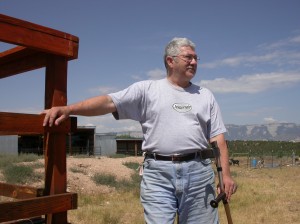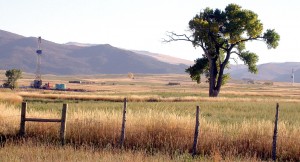 From the top of Grass Mesa, it’s hard to feel much threat from the gas development spreading across the lands below.
From the top of Grass Mesa, it’s hard to feel much threat from the gas development spreading across the lands below.
Garland Anderson’s modest one-story home commands a grandiose view of the Colorado River Valley, from the Grand Hogback cutting a jagged ridge to the east to the Roan Plateau’s sheer bluffs to the west.
But like his neighbors, Anderson knows if drilling rigs haven’t yet reached his home, an 80-acre mesa-top spread he shares with his wife Diana, plus six goats, three horses, 10 cats and two dogs, it’s likely just a matter of time.
The sagebrush, hayfields and rocky ridges that spread south of Silt and Rifle lie on top of the Mamm Creek field, believed to be one of the richest sources of natural gas in the Piceance Basin, and Grass Mesa has seen some of the densest gas development.
That’s made the Andersons, like many neighbors, unwitting activists against the gas industry. Their main battle is with EnCana, the Canadian gas exploration giant that has bought up gas leases throughout the region and launched a dramatic push to extract the natural gas known to lie underneath the scattered homes and ranches.
Landowners have complained that the increased activity has wreaked havoc on the rural area: New roads have scarred the landscape; equipment and traffic has created noise and pollution; wildlife has been scared away; massive compressor stations have been built to keep the wells pumping.

Garland Anderson stands at his Grass Valley home, which sits amid a growing number of gas wells. David Frey photo.
They fear the drilling could damage or decrease their well water, and the industrial activity will harm their property values.
“The only thing that has worked has been to push them to the limit and take it all the way to finally get an attorney to talk to their attorney and they realize that we’re not going to be railroaded and walked on,” Anderson said, “that we are going to defend our rights. We have never asked for anything other than our rights.
“All we want is respect of our property, and them to do the least amount of damage as possible to our properties and to give us some consideration, just as human beings. That’s what we’ve asked for. But it’s been difficult in coming.”
In recent months, the company has become more cooperative, Anderson said, but that’s come only after vigilance by locals.
“They know that until someone slaps their hand, they’re going to do what they can to make that dollar,” he said. “That’s understandable. That’s the American Way. I’m not knocking making the dollar. But we are a lot upset that it is a Canadian company that is doing things here in America that they can’t do at home. … They’re coming down here and destroying our property and sending the money back home.”
Anderson is an unlikely candidate to take on the industry. Before retiring to Colorado, he spent 20 years traveling the globe performing seismic work for major oil companies preparing offshore rigs.
Now, he’s a member of the Grand Valley Citizens Alliance, a group of western Garfield County residents opposing gas development in their backyard, and Western Colorado Congress, a Western Slope activist group working with them.
“Believe me, I never thought about it,” he said. “I was working for the money. That’s what I suspect is going on up here.”
Split estate
At the heart of landowners’ complaints lies the “split estate,” which divides surface rights from mineral rights. As properties are sold and resold, the owners of the land and the minerals are often different. Mineral rights owners may lease their holdings to energy companies, and energy companies have the right to extract them.
Those who don’t own the mineral rights may find energy companies at their doorsteps. They can work out some agreements as to where they can drill, how they should reclaim the land and how much compensation they can get, but their rights are limited, and they can’t turn them away.
Anderson admits he saw gas development below when he bought his home, but he said he and others were led to believe it would never come up the mesa. That’s changed. He’s as critical of EnCana as he is of the former Aspen developer who sold the land, he said, knowing what was coming. The developer now lives in Carefree, Ariz., Anderson said ironically, mineral rights in hand.
“I would say, in my opinion, we were duped,” he said.
Conflicts over severed mineral rights make up the bulk of complaints to the state regulatory agency, the Colorado Oil and Gas Conservation Commission, even though the commission says it has no authority to address them.
“Landowners either don’t accept, don’t understand or don’t want to accept that they don’t own the mineral rights, and they’re property rights that somebody else has the right to access,” said Rich Griebling, the commission’s director.
As a question of property rights, he said, the government can’t stand in the way.
Mineral rights have long been considered legally superior to surface rights in Colorado, giving landowners little recourse if they felt energy companies were trampling them. That changed this year, when the state Supreme Court ruled the two were equal, but what difference that may mean for landowners remains to be seen. Griebling said his commission has seen no change as a result.
“They’re going to interfere with the surface use just to get to their extraction right,” said Garfield County Commissioner John Martin. “If that’s equal, I guess that’s equal.”
Limiting impacts

Richard Eberspecher, drilling superintendent for EnCana, stands at a rig near Rifle, Colo. David Frey photo.
Industry officials say they’re using state-of-the-art techniques to limit impacts.
“I think we’re trying,” said Richard Eberspecher, drilling superintendent at EnCana’s Rifle office. “It’s still, you’ve gotta drill a hole in the ground.”
He points to a pair of pads next to each other in Hunter Mesa, not far from Grass Mesa. They’re big pads – about six acres altogether, but they have four wells on each, maybe 15 feet apart, instead of drilling four separate wells with four pads. They’re using direction drilling – drilling at an angle underground to reach a wider area instead of drilling straight down from separate spots.
“This looks pretty scarred up now, but it won’t look as bad as you think,” Eberspecher said. “It’s a big development. There’s no getting around that. But they’re doing it as good as they can.”
Dave Grisso, operations supervisor at EnCana’s office in Rifle, said the company uses telemetry to monitor activities from the office instead of increasing truck traffic. Gas byproducts once burned off through flaring can now be “flowed back,” captured and sold. A new water treatment plant lets the company reuse 70 percent of what it extracts.
Such advances have limited the impacts, Griebling said. While drilling across the state has been on a rapid rise, he said, complaints haven’t kept pace. The state has let wells be drilled more densely than anywhere else in the country. But in practice, he said, they’re less dense than ever on the surface because of directional drilling.
“What we’ve seen in this decade is industry on its own initiative going beyond the regulatory requirements and reducing impacts on their own,” he said.
On a tour of EnCana’s operations, Grisso pointed to wells that had been reclaimed, leaving only a small cap and vegetation hard to distinguish from the surrounding area. The only weeds are in the adjacent ranchland, he noted.
“It’s beautiful up there,” Grisso said, pointing to Uncle Bob Mountain towering above the mammoth Pumba compressor station in the Mamm Creek area. The mountain is home to what’s considered the highest-altitude gas well in the country, at 10,300 feet. The station is a clutch of rigs, metal buildings and industrial boxes on a dirt pad surrounded by green.
“As an oil and gas person, when you look out over all this and you see a beautiful area, is that like a blight to you?” a reporter asked.
“Development can be done responsibly,” Grisso said. “That’s why you have pad drilling. That’s why you take great efforts for your reclamation. That is a beautiful area.”
Fighting the fight
Opponents say they don’t expect to stop gas development, but they want to make sure energy companies are as gentle as possible.
“It’s so inappropriate for them to be drilling in a rural residential and agricultural area,” said Peggy Utesch, who with her husband Bob moved from Glenwood Springs to four acres south of Silt three years ago.
The Utesches say they knew gas development was on the rise when they moved, but then it was concentrated around Parachute and Rulison. Now it’s beginning to surround them. They don’t own their mineral rights, but they say they doubt a well will appear on their land. But they can’t stop them from coming up around them.
It’s changed the landscape and threatened their environment, Peggy Utesch said, and for ranchers, it could threaten their livelihood.
Getting behind the wheel of her Toyota 4Runner, she pointed to ranches that have become drilling sites.
“It doesn’t look like the bucolic ranchland we just drove through,” she said. “It looks like an industrial site of compressor stations, clusters of gas wells sitting on the surface, roads and large well pads and disturbed soils.”
The couple has become active in fighting the development. It’s not a battle they can win, they say, but they may be able to trim their losses.
“I think if we do nothing, we’ll get run over,” Utesch said. “I think if we fight the fight, it will make it a lot better for people in the long run. We’re not gonna stop development, and that’s certainly not the goal. But we’ve gotta keep them from doing it the bad way. If we don’t fight the fight, they won’t do it the right way.”



